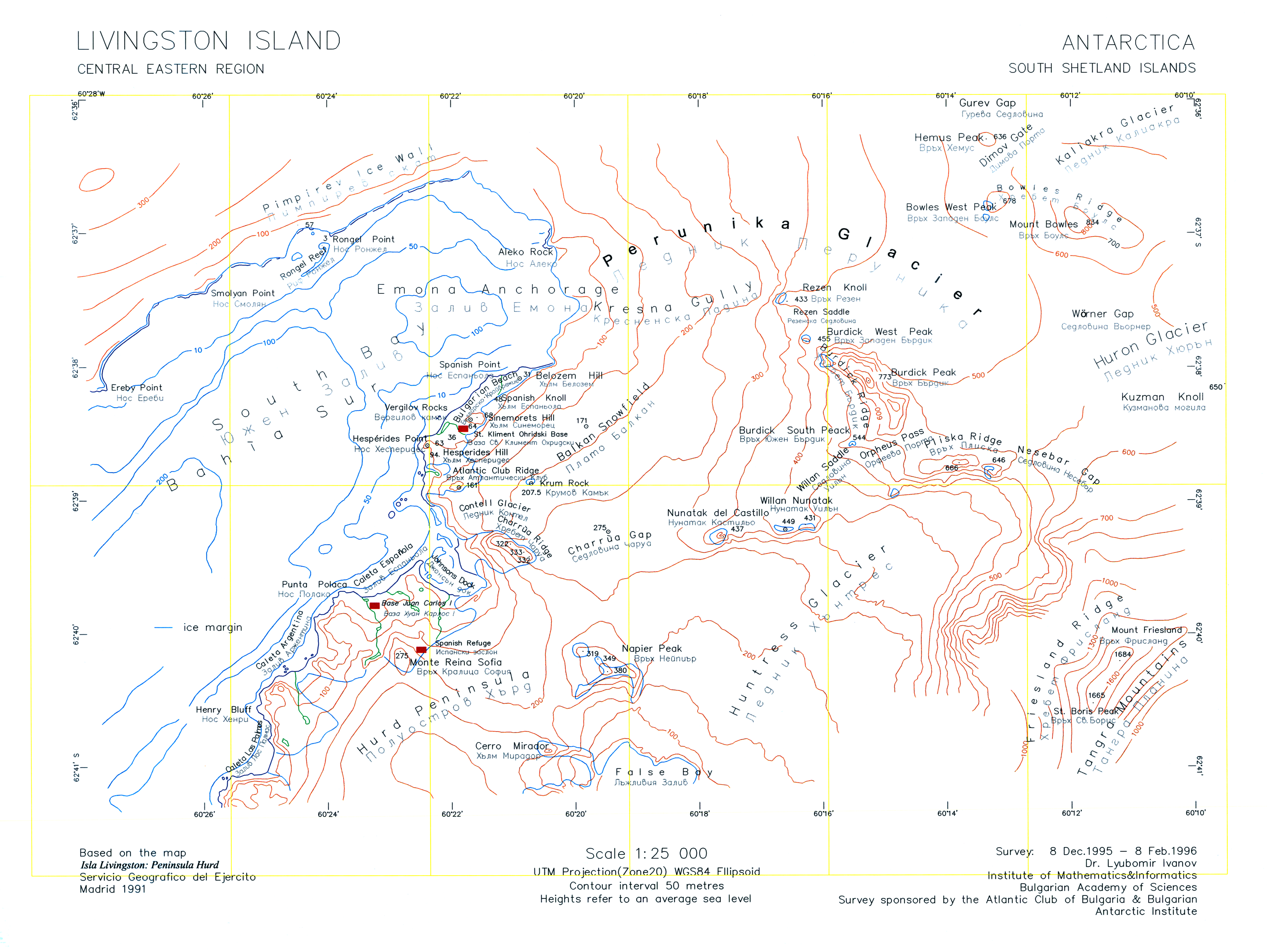|
Krum Rock
Krum Rock ( bg, Krumov Kamak \'kru-mov 'ka-m&k\) is a small nunatak rising to 208 metres on the southwest edge of Balkan Snowfield just north of Contell Glacier on Hurd Peninsula in eastern Livingston Island, one of the South Shetland Islands in Western Antarctica. The rock projects slightly above the ice sheet with some 3,000 square metres of rocky ground exposed on its northern slope in summer. Because of its location rather than prominence, it is a particularly important landmark in the course of field work carried out in the area. Location The nunatak is located at which is 1 km east of Atlantic Club Ridge, 1.2 km southeast of Sinemorets Hill, 2.8 km west by north of Castillo Nunatak, and 1 km north by east of the highest point of Charrúa Ridge. Krum Rock is named for Krum Velchev, meteorologist at St. Kliment Ohridski Base for several seasons since 1993. The name form ''Krumov Kamak'' was well established in use at the time of approval. Maps Isla ... [...More Info...] [...Related Items...] OR: [Wikipedia] [Google] [Baidu] |
Atlantic Club Ridge
The Atlantic Club Ridge ( bg, връх Атлантически Клуб, vrah Atlanticheski Klub, ) is a ridge rising to 161 m on Hurd Peninsula in Eastern Livingston Island, Antarctica. To the west the ridge surmounts the South Bay coast north of Johnsons Dock Johnsons Dock is a sheltered 500 m wide cove indenting for 900 m the northwest coast of Hurd Peninsula on Livingston Island in the South Shetland Islands, Antarctica. It is part of South Bay entered north of Ballester Point. Surmounted by Cha ..., to the south it is bounded by the lower course of the two km long Contell Glacier, to the east by the foot of the Balkan Snowfield sloping up towards Krum Rock and to the northwest by Sea Lion Tarn. The ridge is snow-free in the summer months. The ridge's steep northern slopes are linked with Hesperides Hill by a saddle of 52 m elevation. The higher rocky ground on the Atlantic Club Ridge, as well as on the hills surmounting Bulgarian Beach, is noted for its abundant b ... [...More Info...] [...Related Items...] OR: [Wikipedia] [Google] [Baidu] |
Antarctic Place-names Commission
The Antarctic Place-names Commission was established by the Bulgarian Antarctic Institute in 1994, and since 2001 has been a body affiliated with the Ministry of Foreign Affairs of Bulgaria. The Commission approves Bulgarian place names in Antarctica, which are formally given by the President of the Republic according to the Bulgarian Constitution (Art. 98) and the established international practice. Bulgarian names in Antarctica Geographical names in Antarctica reflect the history and practice of Antarctic exploration. The nations involved in Antarctic research give new names to nameless geographical features for the purposes of orientation, logistics, and international scientific cooperation. As of 2021, there are some 20,091 named Antarctic geographical features, including 1,601 features with names given by Bulgaria.Bulgarian Antarctic Gazett ... [...More Info...] [...Related Items...] OR: [Wikipedia] [Google] [Baidu] |
Composite Antarctic Gazetteer
The Composite Gazetteer of Antarctica (CGA) of the Scientific Committee on Antarctic Research (SCAR) is the authoritative international gazetteer containing all Antarctic toponyms published in national gazetteers, plus basic information about those names and the relevant geographical features. The Gazetteer includes also parts of the International Hydrographic Organization (IHO) General Bathymetric Chart of the Oceans (GEBCO) gazetteer for under-sea features situated south of 60° south latitude. , the overall content of the CGA amounts to 37,893 geographic names for 19,803 features including some 500 features with two or more entirely different names, contributed by the following sources: {, class="wikitable sortable" ! Country ! Names , - , United States , 13,192 , - , United Kingdom , 5,040 , - , Russia , 4,808 , - , New Zealand , 2,597 , - , Australia , 2,551 , - , Argentina , 2,545 , - , Chile , 1,866 , - , Norway , 1,706 , - , Bulgaria , 1,450 , - , G ... [...More Info...] [...Related Items...] OR: [Wikipedia] [Google] [Baidu] |
Meteorologist
A meteorologist is a scientist who studies and works in the field of meteorology aiming to understand or predict Earth's atmospheric phenomena including the weather. Those who study meteorological phenomena are meteorologists in research, while those using mathematical models and knowledge to prepare daily weather forecasts are called ''weather forecasters'' or ''operational meteorologists''. Meteorologists work in government agencies, private consulting and research services, industrial enterprises, utilities, radio and television stations, and in education. They are not to be confused with weather presenters, who present the weather forecast in the media and range in training from journalists having just minimal training in meteorology to full fledged meteorologists. Description Meteorologists study the Earth's atmosphere and its interactions with the Earth's surface, the oceans and the biosphere. Their knowledge of applied mathematics and physics allows them to understand the ... [...More Info...] [...Related Items...] OR: [Wikipedia] [Google] [Baidu] |
Charrúa Ridge
Charrúa Ridge is an ice-free rocky ridge rising to along the northeast coast of Johnsons Dock in Hurd Peninsula, Livingston Island, in the South Shetland Islands, Antarctica. It is narrow and precipitous, extending in a west-northwest to east-southeast direction, with triple heights of elevation 322, 333 and 332 m respectively, and linked to Castillo Nunatak by Charrúa Gap. It surmounts Contell Glacier to the north, South Bay to the west, Johnsons Dock to the southwest and Johnsons Glacier to the south. It forms a prominent landmark in the area between the Spanish Antarctic base Juan Carlos I and the Bulgaria Bulgaria (; bg, България, Bǎlgariya), officially the Republic of Bulgaria,, ) is a country in Southeast Europe. It is situated on the eastern flank of the Balkans, and is bordered by Romania to the north, Serbia and North Macedon ...n Antarctic base St. Kliment Ohridski Base, St. Kliment Ohridski. The feature is named after the ''Charrúa'', one of t ... [...More Info...] [...Related Items...] OR: [Wikipedia] [Google] [Baidu] |
Castillo Nunatak
Castillo Nunatak is a conspicuous rocky peak rising to 437 m on the glacial divide between Huntress Glacier and Balkan Snowfield on Hurd Peninsula in eastern Livingston Island in the South Shetland Islands, Antarctica. It is linked to Charrúa Ridge to the west Charrúa Gap and, via Willan Nunatak and Willan Saddle, to Burdick Ridge to the east-northeast. Castillo Nunatak is a prominent landmark in the Charrúa Gap area. The feature is descriptively named for its abrupt and isolated appearance ('Castle Nunatak' in Spanish). Location The peak is located at which is 860 m west of Willan Nunatak, 2.5 km northeast of Napier Peak Napier Peak is the partly ice-free peak rising to 380 m on Hurd Peninsula, Livingston Island in the South Shetland Islands, Antarctica. It is linked to Charrúa Gap to the north by a 1.5 km ice-covered col, and by an ice-covered saddle to ..., 2,9 km east of Charrúa Ridge and 2.8 km east-southeast of Krum Rock. Detailed Spanish ... [...More Info...] [...Related Items...] OR: [Wikipedia] [Google] [Baidu] |
Sinemorets Hill
Sinemorets Hill (Halm Sinemorets \'h&lm si-ne-'mo-rets\) is the second most prominent (after Hesperides Hill) in the chain of hills surmounting Bulgarian Beach in eastern Livingston Island in the South Shetland Islands, Antarctica. Sinemorets Hill is 380 m long in east-west direction and 230 m wide, with twin heights, the west-southwestern one being 64 m and the east-northeastern one 62 m, sheltering a small pool between them. It is snow free in the summer months and overlooks the Bulgarian base to the southwest. Relics of an old encampment were still discernible at its eastern slope in 1996. Sinemorets is the name of a village and a cape on the Black Sea coast. The hill was named by the United Kingdom Antarctic Place-Names Committee (UK-APC) in 1994 at the request of the Second Bulgarian Antarctic Expedition (1993/94). Location The peak is located at , which is 820 m east-northeast of Hespérides Point, 220 m inland from Greenpeace Rock, 1.2 km northwest of Krum Rock a ... [...More Info...] [...Related Items...] OR: [Wikipedia] [Google] [Baidu] |
Ice Sheet
In glaciology, an ice sheet, also known as a continental glacier, is a mass of glacial ice that covers surrounding terrain and is greater than . The only current ice sheets are in Antarctica and Greenland; during the Last Glacial Period at Last Glacial Maximum, the Laurentide Ice Sheet covered much of North America, the Weichselian ice sheet covered Northern Europe and the Patagonian Ice Sheet covered southern South America. Ice sheets are bigger than ice shelves or alpine glaciers. Masses of ice covering less than 50,000 km2 are termed an ice cap. An ice cap will typically feed a series of glaciers around its periphery. Although the surface is cold, the base of an ice sheet is generally warmer due to geothermal heat. In places, melting occurs and the melt-water lubricates the ice sheet so that it flows more rapidly. This process produces fast-flowing channels in the ice sheet — these are ice streams. The present-day polar ice sheets are relatively young in geol ... [...More Info...] [...Related Items...] OR: [Wikipedia] [Google] [Baidu] |







